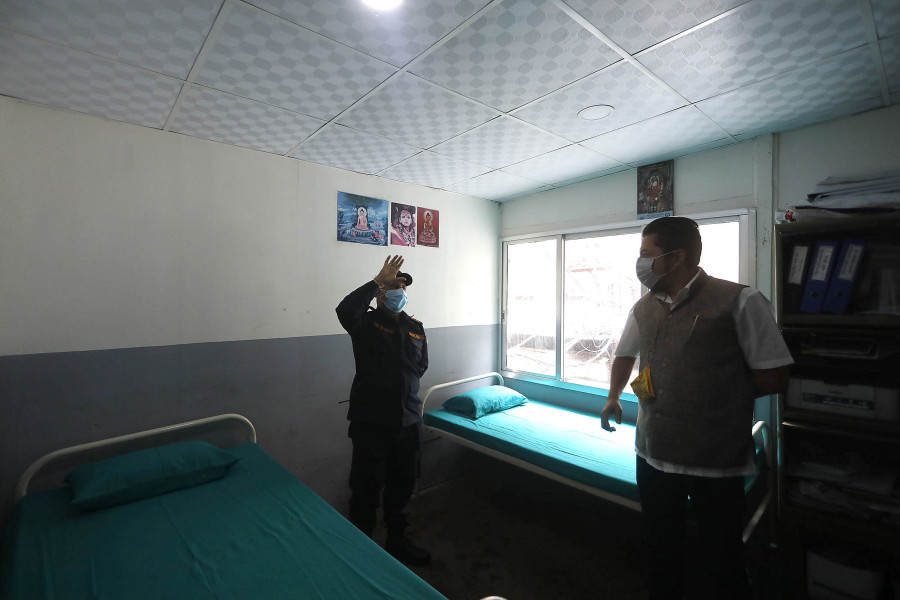Health
As testing is being ramped up, experts stress measures to isolate, monitor infected
Number of daily new cases has slightly come down, but experts say risk continues and authorities must also focus on other containment measures than harsher restrictions.
Arjun Poudel & Anup Ojha
The positivity rate of Covid-19 infections in Nepal was above 40 percent for weeks, although it has been coming down slightly in the last few days.
When there is insufficient testing, positivity rates remain high and according to the World Health Organization, a positivity rate above 5 percent signals that the infection is spreading uncontrollably.
In Nepal tests are simply not being conducted in enough numbers with only some 20,000 polymerase chain reaction tests and less than 500 antigen tests being reported daily.
The government has, however, announced that antigen tests will be ramped up significantly—25,000 a day.
The government has sent 1.7 million antigen test kits, all of which donated by various countries with Switzerland alone giving 1.1 million, to different provinces to increase testing.
“Due to insufficient antigen testing kits, we were unable to expand testing,” said Mahendra Shrestha, chief specialist at the Health Ministry. “Now we have a sufficient number of testing kits, provided by international aid agencies.”
But experts say increasing testing is welcome but this alone is not enough.
“Testing helps to figure out the hotspots and clusters,” Dr Prabhat Adhikari, an infectious disease and critical care expert, told the Post. “Authorities must trace the contacts of infected people, put suspected cases into quarantine and infected persons in isolation, make sure that the infected are not coming out and meeting people, monitor their health conditions, and ensure that they go to hospitals if their conditions deteriorate.”
The Kathmandu Metropolitan City is starting antigen testing in all its 32 wards from Friday.
“We will conduct tests on symptomatic patients and also those who have come in contact with them,” said Hari Kunwar, chief of the City’s public health division.
Kathmandu has been the epicentre of coronavirus infections in the second wave with Kathmandu Metropolitan City so far reporting a total of 59,445 infections. The active case count as of Thursday was 11,043.
So far, across the country only symptomatic cases are getting tested mostly and one reason for this is that the daily capacity of the some 90 PCR testing laboratories is around 20,000, according to the Health Ministry.
“It’s good to expand antigen tests because it helps in tracing how the virus is spreading in communities,” said Dr Sher Bahadur Pun, chief of the Clinical Research Unit at Sukraraj Tropical and Infectious Disease Hospital. “If only it had been carried out earlier, infections would have stopped because it would immediately trace out infections and this could have helped us understand the nature of the virus spread.”
So far, only those getting severely ill had been coming to hospitals, according to doctors, and with no diagnosis in time, chances of infected people spreading the virus were high.
“One reason deaths have continued to mount is that the infected come to hospitals too late,” Dr Sagar Rajbhandari, director at Sukraraj Tropical and Infectious Disease Hospital, told the Post.
Authorities estimate that 80 percent of the asymptomatic infected people, whose conditions are not severe, are not being tested and this is one reason for the coronavirus to have penetrated deep into society.
Kathmandu Valley, along with the rest of the country, has been under prohibitory orders for a month since April 29, but the number of daily infections has remained stubbornly at about the 8,000 mark since May 5, except for the last two days.
On Thursday, Nepal reported 6,731 new infections, taking the total number of cases to 542,256 and the number of active cases stands at 116,476. The Ministry of Health and Population reported 106 more Covid-19 fatalities taking the total death toll to 6,951.
Kathmandu Valley continues to record a significant proportion of the total new cases every day and on Thursday, it reported 2,367 new infections.
Beginning Friday, harsher prohibitory measures are being imposed in the Valley as per which groceries will not be allowed to open for a week and office vehicles will be allowed on the roads only at fixed times in the mornings and evenings.
The government seeing lockdowns as the only measure to check the spread of coronavirus has been widely criticised.
“I don’t understand the logic behind extending the lockdown and making it even harsher, without doing other basic things'' said Dr Basudev Pandey, former director of the Epidemiology and Disease Control Division. “Extending and making prohibitory orders harsher can give respite for authorities in controlling the possible political crowds, but it is not a solution in itself.”
Officials’ diktat that people buy daily essentials for a week with a two-day notice has met with widespread criticism. The panic buying triggered by the order led to crowds at grocery shops in Kathmandu Valley, causing concerns among doctors.
Experts, however, hope that ramping up testing will allow authorities to move towards lifting of restrictions.
“We cannot continue restrictions for an indefinite period,” Dr Biraj Karmacharya, an epidemiologist at Dhulikhel Hospital, told the Post. “Authorities should first know where the virus has been spreading and where not and then can loosen up restrictions gradually.”
But loosening restrictions have to be carefully managed, experts stress.
“Mechanisms should be created to regulate the movement of outsiders into areas where huge numbers of tests are performed,” said Adhikari, the infectious disease expert.




 8.12°C Kathmandu
8.12°C Kathmandu
.jpg)














